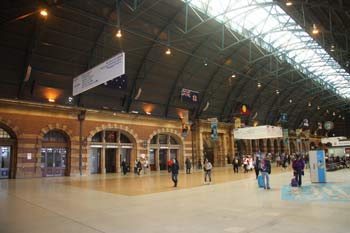Australia-A Martin Audio OmniLine system has been specified and installed at Central Railway Station in Sydney,the largest in Australia,to conquer a speech intelligibility problem that has persisted for years.

The Country Trains Concourse,measuring 110m x 60m x 10m,and with a challenging RT60 time of 5.5 seconds in the mid-band,has long defied attempts to get intelligible announcements heard by commuters.Over the years many brands have successively tried and failed to tame the inherent reverberation caused by a combination of terrazzo floors,sandstone and plate glass walls and a high arched steel roof.
Last year Glenn Leembruggen,principal of Acoustic Directions,became the latest specialist to do battle with the acoustically hostile environment.
Since acoustic treatment of the inside of the roof was ruled out as being financially untenable,two members of the Acoustic Directions team,David Connor and David Gilfillan,decided to trial several software-driven systems,and investigate different steerable line array solutions.
They ultimately concluded that a Martin Audio OmniLine system,with DSP processing,would produce the best quality and best speech clarity.They duly specified 120 steered elements-supplied by TAG,Martin Audio's Australian distributors.
Modular and scalable,this particular OmniLine installation used a special version of the Martin Audio Display software(operating under an FIR filtering regime that addressed every element in the array with its own processed channel).The intelligent software enabled the array to be configured to deliver sound precisely over the venue's vertical profile without spillage.Furthermore,elimination of high-frequency side-lobes gives OmniLine an advantage over conventional DSP steered columns making it suitable for high quality speech and music reproduction even in reverberant spaces such as railway station concourses.
Thus Acoustic Directions were able to simultaneously optimise the direct field over the listening area,keep the sound off reflective rear walls,and minimise reverberant sound power.The result is remarkably high intelligibility throughout the concourse,even at rush hour,when as many as 3,000 passengers are adding to the cacophony of noise resonating around this vast cavern.
With the amps situated as much as 200m away from the speakers,a 100 Volt system was required,and Acoustic Directions worked with Harbuch Electronics to develop a 100V loudspeaker transformer that was ultra-flat and with only 10 degrees of phase shift at 20kHz.The FIR filters that beam control the array are implemented in Nion processors with the loudspeakers being driven by 8-channel 2.4kW amplifiers(to provide 120 amp channels).
Acoustic Directions optimised the frequency responses over the listening area using time-windowed impulse responses.
The installation also picked up a coveted Rutledge AV Industry Award(an AVIA)with the judges commending Acoustic Directions'meticulous implementation of the modelling,installation and commissioning of the system.





